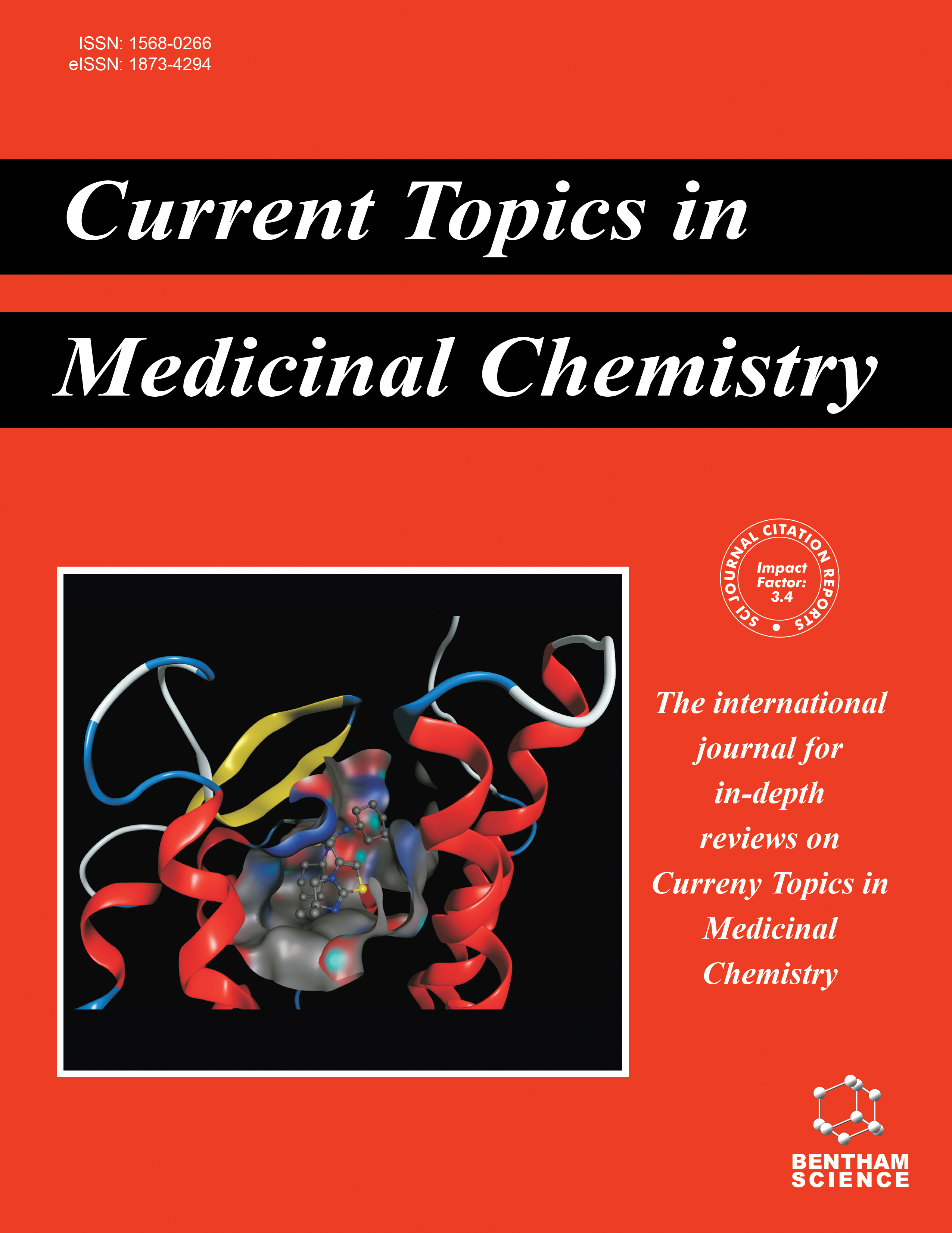- Home
- A-Z Publications
- Current Topics in Medicinal Chemistry
- Previous Issues
- Volume 11, Issue 6, 2011
Current Topics in Medicinal Chemistry - Volume 11, Issue 6, 2011
Volume 11, Issue 6, 2011
-
-
Editorial [Hot topic: G-Protein Coupled Receptors: Drug Targets of Key Importance (Guest Editors: Luca Piali and Christoph Boss)]
More LessAuthors: Luca Piali and Christoph BossAs guest editors of this thematic issue of Current Topics in Medicinal Chemistry focusing on “Deorphanized GPCRs in Medicinal Chemistry and Drug Discovery” we would like to thank all the contributors for their support and the submission of excellent articles to important key aspects of GPCR-research. Many medically significant biological processes are mediated by proteins participating in signal transduction pathways that inv Read More
-
-
-
The Role of Corticotropin-Releasing Hormone in the Pathophysiology of Depression: Therapeutic Implications
More LessAuthors: R. Brett Lloyd and Charles B. NemeroffStress responses have been posited to be a key component of mental health and disease by playing essential roles both in normal adaptive processes and maladaptive physiological responses that in part underlie the pathogenesis of certain subtypes of mood and anxiety disorders. Early research focused on delineating the function of the hypothalamicpituitary- adrenal (HPA) axis and subsequently examined its role in me Read More
-
-
-
EBI2, GPR18, and GPR17 - Three Structurally Related but Biologically Distinct 7TM Receptors
More LessAuthors: Kristine Norregaard, Tau Benned-Jensen and Mette Marie Rosenkilde7TM receptors constitute one of the largest superfamilies of proteins in the human genome. They are involved in a large number of physiological and pathological processes and thus represent major and important drug targets for the pharmaceutical industry. Although the majority have been deorphanized, many remain orphan and these orphan receptors constitute a large pool of potential drug targets. This review focuses on Read More
-
-
-
Novel Anti-Inflammatory-Pro-Resolving Mediators and Their Receptors
More LessAuthors: Charles N. Serhan, Sriram Krishnamoorthy, Antonio Recchiuti and Nan ChiangResolution of inflammation, an actively coordinated program, is essential to maintain host health. It involves effective removal of inflammatory stimuli and the spatio-temporal control of leukocyte trafficking as well as chemical mediator generation. During the active resolution process, new classes of small, local acting endogenous autacoids, namely the lipoxins, D and E series resolvins, (neuro)protectins, and maresins have Read More
-
-
-
The Evolution of Histamine H3 Antagonists/Inverse Agonists
More LessAuthors: Evan P. Lebois, Carrie K. Jones and Craig W. LindsleyThis article describes our efforts along with recent advances in the development, biological evaluation and clinical proof of concept of small molecule histamine H3 antagonists/inverse agonists. The H3 receptor is a presynaptic autoreceptor within the Class A GPCR family, but also functions as a heteroreceptor modulating levels of neurotransmitters such as dopamine, acetylcholine, norepinephrine, serotonin, GABA Read More
-
-
-
Molecular Determinants of Selective Agonist and Antagonist Binding to the Histamine H4 Receptor
More LessAuthors: Enade P. Istyastono, Chris de Graaf, Iwan J.P. de Esch and Rob LeursThe deorphanization of the histamine H4 receptor (H4R) has led to a significant number of scientific publications and patent applications. Whereas some histamine H1, H2 and H3 receptor ligands were found to have significant affinity for H4R, several agonists and antagonists with high affinity for H4R and selectivity over the other histamine receptors were successfully designed and synthesized. Moreover, site-directed mutatio Read More
-
-
-
mGluR5 Negative Allosteric Modulators Overview: A Medicinal Chemistry Approach Towards a Series of Novel Therapeutic Agents
More LessAllosteric modulators of metabotropic glutamate receptors (mGluRs) subtypes 1-8 have been shown to offer a valid way to develop small molecule non aminoacid-like therapeutics that can be administered orally and that readily cross the blood-brain barrier. Allosteric modulators of glutamatergic receptors and in particular mGluR5 have emerged as a novel and highly desirable class of compounds for the treatment Read More
-
-
-
Discovery of Dual Orexin Receptor Antagonists (DORAs) for the Treatment of Insomnia
More LessAuthors: Paul J. Coleman, Christopher D. Cox and Anthony J. RoeckerOrexins are excitatory neuropeptides that have a critical role in maintaining wakefulness. Orexin receptor antagonists promote sleep in animals and humans. Indeed, small molecule orexin receptor antagonists have demonstrated clinical proof-of-concept in the treatment of primary insomnia. This review describes optimization of orexin receptor antagonists across diverse structural classes with a focus on how molecules were Read More
-
-
-
Synthetic Sphingosine 1-Phosphate Receptor Modulators - Opportunities and Potential Pitfalls
More LessAuthors: Martin H. Bolli, Cyrille Lescop and Oliver NaylerSphingosine 1-phosphate (S1P) evokes a plethora of physiological responses by stimulating members of a G protein-coupled receptor family, known as S1P receptors. Currently five different mammalian S1P receptor subtypes, S1P1-5, each with a different cellular expression pattern, were identified. The S1P1 receptor in particular has attracted major interest throughout the pharmaceutical industry following the breakthrou Read More
-
Volumes & issues
-
Volume 25 (2025)
-
Volume 24 (2024)
-
Volume 23 (2023)
-
Volume 22 (2022)
-
Volume 21 (2021)
-
Volume 20 (2020)
-
Volume 19 (2019)
-
Volume 18 (2018)
-
Volume 17 (2017)
-
Volume 16 (2016)
-
Volume 15 (2015)
-
Volume 14 (2014)
-
Volume 13 (2013)
-
Volume 12 (2012)
-
Volume 11 (2011)
-
Volume 10 (2010)
-
Volume 9 (2009)
-
Volume 8 (2008)
-
Volume 7 (2007)
-
Volume 6 (2006)
-
Volume 5 (2005)
-
Volume 4 (2004)
-
Volume 3 (2003)
-
Volume 2 (2002)
-
Volume 1 (2001)
Most Read This Month
Article
content/journals/ctmc
Journal
10
5
false
en


